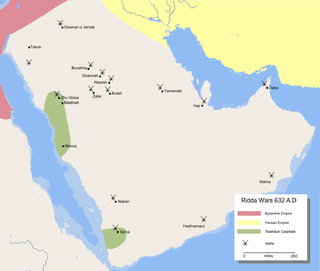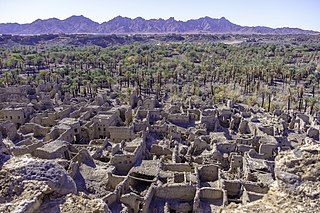| Rakuba | |
|---|---|
| Geography | |
| Location | |
| Geology | |
| Mountain type | Mountain road |
Rukuba is a mountain road in Saudi Arabia.
| Rakuba | |
|---|---|
| Geography | |
| Location | |
| Geology | |
| Mountain type | Mountain road |
Rukuba is a mountain road in Saudi Arabia.
Al-Bakri stated that: "Rukuba is a mountain road that presents a number of challenges to navigation due to its uneven terrain." [1]
This route was traversed by the Muhammad during the Expedition of Tabuk and his Hijrah to Medina. [2]
Al-Zamakhshari Stated that: "It is a mountain road presents a challenging and uneven surface that requires careful navigation." [3]
Al-Iskandari stated that: "Rakuba it is a mountain road presents a challenging and uneven surface between Mecca and Medina". [4]
Yaqut al-Hamawi Stated that: "Muhammad traversed the route while undertaking the hijrah to Medina, situated in proximity to Wareqan Mountain and Edqes Mountain." [5]
Bin Abd Alhaqq Albaghdadi stated that: "It is a mountain road that presents a number of challenges to navigation due to its uneven terrain between Mecca and Medina, at Al-Araj, near Wareqan Mountain, on which Muhammad have traveled during the Hijrah." [6]
Al-Samhudi Stated that: "A mountain road between Mecca and Medina at Al-Araj, three miles from it to the direction of Medina, as will be mentioned in Al-Mudarj. Ibn Ishaq states in his account of Hijrah that the group's guide proceeded to lead them from al-Arj to Thaniyat al-Ghayr, situated to the right of Rukuba."
Al-Majd said: "Muhammad rode a proverbially difficult fold when he migrated to Medina, near Wareqan Mountain and Edqes Mountain, and was accompanied by Abdullah bin Abdu-nahm." [7]
Al-Blady Al-Harby stated that: "The term "Rakuba" is a transliteration of the word "riding", which was mentioned during the Hijrah."
He Said: "Subsequently, the group's guide proceeded to lead them out of Al-Araj and took them to Thunyat al-Ghayr, situated to the right of Rakuba. Ibn Hisham states that Rakuba is situated to the right of Thunyat al-Ghayr for those embarking on the journey to Medina." [8]
Muḥammad ibn ʿAbd al-Wahhāb ibn Sulaymān al-Tamīmī (1703–1792) was a Sunni Muslim scholar, theologian, preacher, activist, religious leader, jurist, and reformer, who was from Najd in central Arabia and is considered as the eponymous founder of the Wahhabi movement. His prominent students included his sons Ḥusayn, Abdullāh, ʿAlī, and Ibrāhīm, his grandson ʿAbdur-Raḥman ibn Ḥasan, his son-in-law ʿAbdul-ʿAzīz ibn Muḥammad ibn Saʿūd, Ḥamād ibn Nāṣir ibn Muʿammar, and Ḥusayn āl-Ghannām.

Mecca is the capital of Mecca Province in the Hejaz region of western Saudi Arabia; it is the holiest city according to Islam. It is 70 km (43 mi) inland from Jeddah on the Red Sea, in a narrow valley 277 m (909 ft) above sea level. Its metropolitan population in 2022 was 2.4 million, making it the third-most populated city in Saudi Arabia after Riyadh and Jeddah. Around 44.5% of the population are Saudi citizens and around 55.5% are Muslim foreigners from other countries. Pilgrims more than triple the population number every year during the Ḥajj pilgrimage, observed in the twelfth Hijri month of Dhūl-Ḥijjah. With over 10.8 million international visitors in 2023, Mecca was one of the ten most visited cities in the world.

Medina, officially Al-Madinah al-Munawwarah and also commonly simplified as Madīnah or Madinah, is the capital of Medina Province in the Hejaz region of western Saudi Arabia. It is one of the oldest and most important places in Islamic history. One of the most sacred cities in Islam, the population as of 2022 is 1,411,599, making it the fourth-most populous city in the country. Around 58.5% of the population are Saudi citizens and 41.5% are foreigners. Located at the core of the Medina Province in the western reaches of the country, the city is distributed over 589 km2 (227 sq mi), of which 293 km2 (113 sq mi) constitutes the city's urban area, while the rest is occupied by the Hejaz Mountains, empty valleys, agricultural spaces and older dormant volcanoes.

Najd is the central region of Saudi Arabia, in which about a third of the country's modern population resides. It is the home of the House of Saud, from which it pursued unification with Hejaz since the time of the Emirate of Diriyah.

Taif is a city and governorate in the Province of Makkah in Saudi Arabia. Located at an elevation of 1,879 m (6,165 ft) in the slopes of the Hijaz Mountains, which themselves are part of the Sarat Mountains, the city has a population of 563,282 people in 2022, making it one of the most populous cities in the kingdom.

The Rashidi dynasty, also called Al Rashid or the House of Rashid, was a historic Arabian House or dynasty that existed in the Arabian Peninsula between 1836 and 1921. Its members were rulers of the Emirate of Ha'il and the most formidable enemies of the House of Saud, rulers of the Emirate of Nejd. They were centered in Ha'il, a city in northern Najd that derived its wealth from being on the route of the Hajj pilgrimage to Mecca, and was also a commercial center. The rulers of Ha'il were the sons of Abdullah bin Rashid, founder of the dynasty.

Banū Tamīm is an Arab tribe that originated in Najd in the Arabian Peninsula. It is mainly present in Saudi Arabia, Qatar, Kuwait, Iraq, Jordan and Lebanon, a strong presence in Algeria, and Morocco, Palestine, Tunisia, and Libya. It is also present in many other parts of the Arab world such as Egypt and Khuzestan in Iran. The word Tamim in Arabic means strong and solid. It can also mean those who strive for perfection.

The Ridda Wars were a series of military campaigns launched by the first caliph Abu Bakr against rebellious Arabian tribes, some of which were led by rival prophet claimants. They began shortly after the death of the Islamic prophet Muhammad in 632 and concluded the next year, with all battles won by the Rashidun Caliphate.

Khaybar is an oasis in Medina Province, Saudi Arabia, situated some 153 kilometres (95 mi) north of the city of Medina. Prior to the arrival of Islam in the 7th century, the area had been inhabited by Arabian Jewish tribes until it fell to Muslim invaders under Muhammad during the Battle of Khaybar in 628 CE.
The Hadith of Najd is a hadith in Sahih Bukhari with several chains of narration about three geographical locations, one of which is prophesied to be the source of calamities. Sunni Muslims accept that the classification of the hadith as "sahih" (authentic).

Muhammad al-Hasan ibn Alawi ibn al-Abbas ibn Abd al-Aziz (1944–2004), also known as Muhammad ibn Alawi al-Maliki, was one of the foremost traditional Sunni Islamic scholar of contemporary times from Saudi Arabia. He is considered to be the Mujaddid of 20th-21st century.
Nur al-Din Ali ibn Abd Allah ibn Ahmad al-Hasani al-Samhudi, better known as Nur al-Din al-Samhudi was an Arab Sunni Islamic scholar from the 15th century. He was a well-known Shafi'i jurist, hadith scholar, mufti and historian of Medina. He is best known for his history of the city of Medina entitled Wafa al-Wafa bi Akhbar Dar al-Mustafa. He is known to be the last person to enter and clean the Inner Chamber of the prophet Muhammad's grave.
Banu Hanifa is an ancient Arab tribe inhabiting the area of al-Yamama in the central region of modern-day Saudi Arabia. The tribe belongs to the great Rabi'ah branch of North Arabian tribes, which also included Abdul Qays, Taghlib, al-Nammir ibn Qasit, and Anazzah. Though counted by the classical Arab genealogists as a Christian branch of Bani Bakr, they led an independent existence prior to Islam. The ruling House of Saud of Saudi Arabia belongs to it.

Selaʾ is a mountain in Medina in modern Saudi Arabia.
The Ghamd is an Azd Arab tribe of the Hejaz Region. They are predominantly Sunni, and are considered one of the oldest tribes of the Arabian Peninsula. The Ghamid people are thought to be closely related to the neighboring tribe of Zahran.
Al-Ajrad is a mountain located in the northwest of Medina, about 90 kilometers from it, to the northeast of Yanbu, about 100 kilometers from it. Buwat Valley is located below it. It is called Al-Ajrad (hairless) because it is stripped of vegetation and has few trees, which is the opposite of the Al-Ashaar (hairy), which is dotted with trees.
Wareqan Mountain is one of the Medina region mountains, it is located southwest of Medina, seventy kilometers away on the Al-Hijra highway, and is 2400 meters above sea level and is also known as the Ouf Mountains after the tribe of Bani Ouf from Harb Tribe. Wareqan Mountain was mentioned in the Islamic narrative by Muhammad when he said, "The infidel's tooth on the Day of Judgment is like Uhud, the width of his skin is seventy cubits, his neck is like Al-Bayda, his thigh is like Wareqan, and his seat in the Hellfire is like what between me and Al-Rabadha."
Ubla are mountains in the Medina region.
Al-Zulfi is the most populous city in the Al-Zulfi Governorate, which encompasses the Al-Zulfi Emirate of Riyadh Province within the Kingdom of Saudi Arabia. It is situated in the center of the governorate, on the periphery of Shuaib Samnan, between the Tuwaiq Mountains and the sand dunes of Nafud al-Thuwairat. The city's population is 68,317.

The Khindif also known as the Banu Ilyas ibn Mudar are a group of Mudarite Arab tribes that descend from the patriarch Ilyas ibn Mudar. The tribes of Banu Tamim, Banu Kinana, Banu Hudhayl and Banu Asad are amongst the various branches of the Khindif group. The Khindif are also ancestors of the Quraysh tribal confederation.